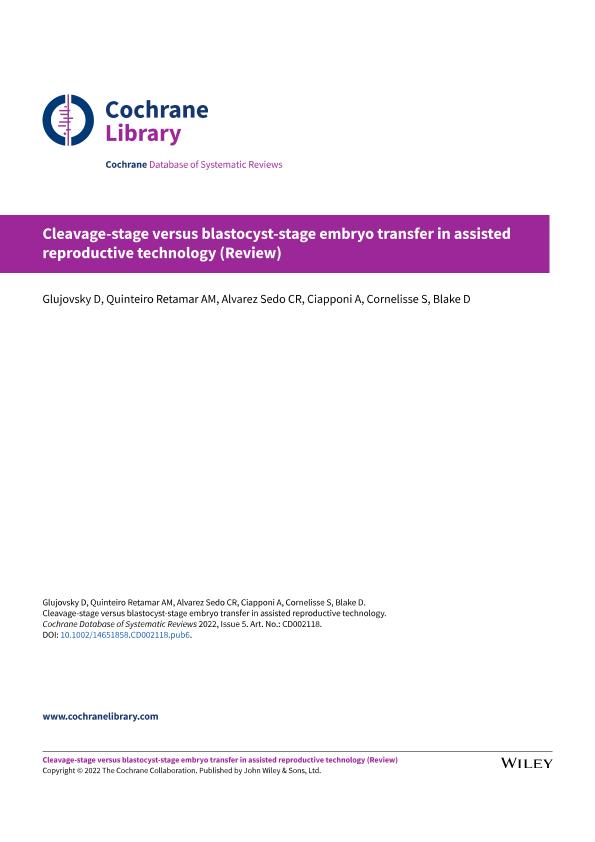Artículo
Cleavage-stage versus blastocyst-stage embryo transfer in assisted reproductive technology
Glujovsky, Demián; Quinteiro Retamar, Andrea Marta; Alvarez Sedo, Cristian Roberto; Ciapponi, Agustín ; Cornelisse, Simone; Blake, Deborah
; Cornelisse, Simone; Blake, Deborah
 ; Cornelisse, Simone; Blake, Deborah
; Cornelisse, Simone; Blake, Deborah
Fecha de publicación:
05/2022
Editorial:
John Wiley & Sons
Revista:
Cochrane Database of Systematic Reviews
ISSN:
1465-1858
Idioma:
Inglés
Tipo de recurso:
Artículo publicado
Clasificación temática:
Resumen
Background: Advances in embryo culture media have led to a shift in in vitro fertilisation (IVF) practice from cleavage-stage embryo transfer to blastocyst-stage embryo transfer. The rationale for blastocyst-stage transfer is to improve both uterine and embryonic synchronicity and enable self selection of viable embryos, thus resulting in better live birth rates. Objectives: To determine whether blastocyst-stage (day 5 to 6) embryo transfer improves the live birth rate (LBR) per fresh transfer, and other associated outcomes, compared with cleavage-stage (day 2 to 3) embryo transfer. Search methods: We searched the Cochrane Gynaecology and Fertility Group Specialised Register of controlled trials, CENTRAL, MEDLINE, Embase, PsycINFO, and CINAHL, from inception to October 2021. We also searched registers of ongoing trials and the reference lists of studies retrieved. Selection criteria: We included randomised controlled trials (RCTs) which compared the effectiveness of IVF with blastocyst-stage embryo transfer versus IVF with cleavage-stage embryo transfer. Data collection and analysis: We used standard methodological procedures recommended by Cochrane. Our primary outcomes were LBR per fresh transfer and cumulative clinical pregnancy rates (cCPR). Secondary outcomes were clinical pregnancy rate (CPR), multiple pregnancy, high-order multiple pregnancy, miscarriage (all following first embryo transfer), failure to transfer embryos, and whether supernumerary embryos were frozen for transfer at a later date (frozen-thawed embryo transfer). We assessed the overall quality of the evidence for the main comparisons using GRADE methods. Main results: We included 32 RCTs (5821 couples or women). The live birth rate following fresh transfer was higher in the blastocyst-stage transfer group (odds ratio (OR) 1.27, 95% confidence interval (CI) 1.06 to 1.51; I2 = 53%; 15 studies, 2219 women; low-quality evidence). This suggests that if 31% of women achieve live birth after fresh cleavage-stage transfer, between 32% and 41% would do so after fresh blastocyst-stage transfer. We are uncertain whether blastocyst-stage transfer improves the cCPR. A post hoc analysis showed that vitrification could increase the cCPR. This is an interesting finding that warrants further investigation when more studies using vitrification are published. The CPR was also higher in the blastocyst-stage transfer group, following fresh transfer (OR 1.25, 95% CI 1.12 to 1.39; I2 = 51%; 32 studies, 5821 women; moderate-quality evidence). This suggests that if 39% of women achieve a clinical pregnancy after fresh cleavage-stage transfer, between 42% and 47% will probably do so after fresh blastocyst-stage transfer. We are uncertain whether blastocyst-stage transfer increases multiple pregnancy (OR 1.05, 95% CI 0.83 to 1.33; I2 = 30%; 19 studies, 3019 women; low-quality evidence) or miscarriage rates (OR 1.12, 95% CI 0.90 to 1.38; I2 = 24%; 22 studies, 4208 women; low-quality evidence). This suggests that if 9% of women have a multiple pregnancy after fresh cleavage-stage transfer, between 8% and 12% would do so after fresh blastocyst-stage transfer. However, a sensitivity analysis restricted only to studies with low or 'some concerns' for risk of bias, in the subgroup of equal number of embryos transferred, showed that blastocyst transfer probably increases the multiple pregnancy rate. Embryo freezing rates (when there are frozen supernumerary embryos for transfer at a later date) were lower in the blastocyst-stage transfer group (OR 0.48, 95% CI 0.40 to 0.57; I2 = 84%; 14 studies, 2292 women; low-quality evidence). This suggests that if 60% of women have embryos frozen after cleavage-stage transfer, between 37% and 46% would do so after blastocyst-stage transfer. Failure to transfer any embryos was higher in the blastocyst transfer group (OR 2.50, 95% CI 1.76 to 3.55; I2 = 36%; 17 studies, 2577 women; moderate-quality evidence). This suggests that if 1% of women have no embryos transferred in planned fresh cleavage-stage transfer, between 2% and 4% probably have no embryos transferred in planned fresh blastocyst-stage transfer. The evidence was of low quality for most outcomes. The main limitations were serious imprecision and serious risk of bias, associated with failure to describe acceptable methods of randomisation. Authors' conclusions: There is low-quality evidence for live birth and moderate-quality evidence for clinical pregnancy that fresh blastocyst-stage transfer is associated with higher rates of both than fresh cleavage-stage transfer. We are uncertain whether blastocyst-stage transfer improves the cCPR derived from fresh and frozen-thawed cycles following a single oocyte retrieval. Although there is a benefit favouring blastocyst-stage transfer in fresh cycles, more evidence is needed to know whether the stage of transfer impacts on cumulative live birth and pregnancy rates. Future RCTs should report rates of live birth, cumulative live birth, and miscarriage. They should also evaluate women with a poor prognosis to enable those undergoing assisted reproductive technology (ART) and service providers to make well-informed decisions on the best treatment option available.
Archivos asociados
Licencia
Identificadores
Colecciones
Articulos(CIESP)
Articulos de CENTRO DE INVESTIGACIONES EN EPIDEMIOLOGIA Y SALUD PUBLICA
Articulos de CENTRO DE INVESTIGACIONES EN EPIDEMIOLOGIA Y SALUD PUBLICA
Citación
Glujovsky, Demián; Quinteiro Retamar, Andrea Marta; Alvarez Sedo, Cristian Roberto; Ciapponi, Agustín; Cornelisse, Simone; et al.; Cleavage-stage versus blastocyst-stage embryo transfer in assisted reproductive technology; John Wiley & Sons; Cochrane Database of Systematic Reviews; 2022; 5; 5-2022; 1-126
Compartir
Altmétricas



